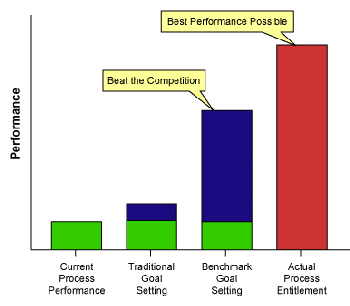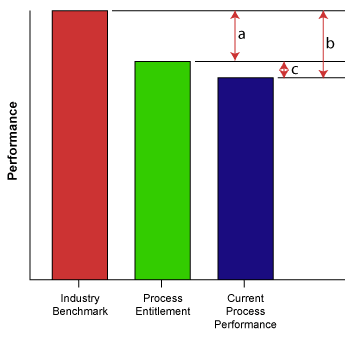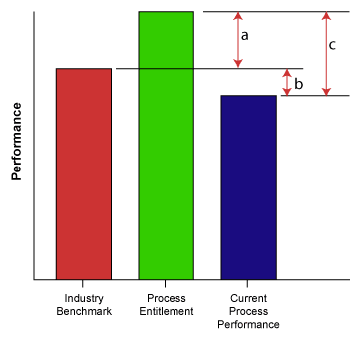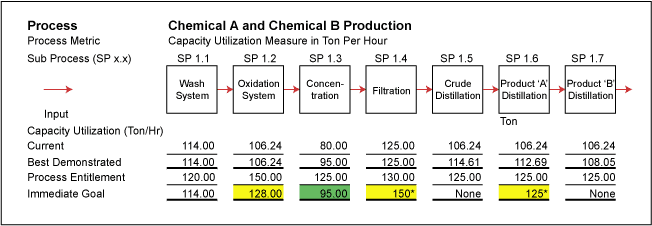
When a Six Sigma project is unsuccessful, a common cause of the failure is a poor project selection process. Compounding the problem of project failure, incorrect and inappropriate projects transmit a negative message to the organization about Six Sigma and can lead to the impression that the methodology is not applicable to all types of industries.
To resolve project selection problems, organizations adopt various approaches such as comparison studies, brainstorming, policy deployment and benchmarking – external and internal – to determine process performance gaps and identify improvement opportunities. Unfortunately, most of these exercises fall short of reaching the overall objective due to their inherent conceptual background.
Total Opportunity Assessment
So what is the right course of action? Process entitlement analysis is a concept that provides an effective and robust process to conduct a total improvement opportunity assessment within any organization. Process entitlement represents the best performance possible from a process. For example, process entitlement for one round of golf (18 holes) is 18 strokes.
Similarly, process entitlement for:
- Cost of poor quality = 0
- Rolled throughput yield = 100%
- Efficiency = 100%
Process entitlement is a robust concept for understanding the true capability of the current operation. A process entitlement analysis enables organizations to extract the untapped value available in the current operation, business or system without any major investment.
A process entitlement study helps envision the scope for improvement, which assists in defining the improvement objectives. It focuses on short-term process capability, the actual capability of a process. In addition, the study identifies the performance gap.
Process Redesign or Improvement?
In a benchmarking exercise, the focus is a comparison of industry best performances or competitor performance levels. In an entitlement study, the focus is the ideal performance possible from the process (Figure 1). The outcome of the analysis also helps decide whether the initiative should involve process improvement (DMAIC) or process redesign (Design for Six Sigma).

Scenario 1 (Figure 2): The current process performance is close to entitlement level and competitors are still far ahead.
In this case, the effort that an organization will expend to improve its process, will not exceed process performance beyond the competitor performance since the operation process has reached its saturation level. This situation requires a process redesign to achieve the business objectives.

Scenario 2 (Figure 3): The organization is operating far below the process entitlement level. By focusing on process improvement, the organization can deliver better value to its stakeholders. Working toward process redesign is a waste at this time.

Why an Entitlement Study Works
Here is why the process entitlement analysis works:
Independent process evaluation: The entitlement study is not dependent on any external information. It also is independent in terms of geographical location, people competency, product, technology, customers and suppliers.
Internal reference: Since the entitlement value calculated by the internal team is based on an internal metrics management system, the information is more reliable and authentic compared to benchmarking, where the organization heavily depends on external information sources.
Ideal still real: Though the process entitlement level calculation is based on ideal performance scenarios, it is considered as practically achievable since the entitlement value is based on proven scientific, empirical or technological principles.
Long-term vision with short-term action: Entitlement can assist in setting long-term targets for process improvement or process redesign. If there is a huge gap between current performance and entitlement level, then the organization can use a short-term plan to reach immediate strategic milestones with the final goal targeted in the next two or three steps.
How to Conduct an Entitlement Assessment
To achieve the best outcome from a process entitlement assessment, an organization must position it as a common business process improvement opportunity assessment for the organization or its business sub-unit(s). There is a three-step methodology for total opportunity assessment – align, assess, approve.
Step 1 – Align: Align the improvement opportunity assessment with the organizational vision, long-term and short-term strategic goals. Identify key processes to achieve business goals.
Step 2 – Assess: Conduct an entitlement assessment for key identified processes. Identify performance gaps and define improvement opportunities (refer to the example below for a detailed illustration).
While conducting the process entitlement assessment, adopt process metrics (first pass yield, rolled throughput yield, cycle time, cost of poor quality, capacity utilization and utility consumption) in place of traditional output performance metrics as they present less bias. Process metrics do create a new set of metrics for the organization, but that brings about a paradigm shift in realizing the current process performance level.
An organization needs to pay critical attention to its answers to the following key questions:
- Current performance baseline: How good is the current process?
- Best demonstration performance: How good has it ever been?
- Potential entitlement level: How good could it be?
Also evaluate and validate pain areas and rudimentary opportunities collected during the Align step.
Step 3 – Approve: Prioritize improvement opportunities as per the short-term business plan, operational goal complexity and resource requirements. Finally, validate and approve the final list of opportunities as probable Six Sigma Black Belt and Green Belt projects and technical projects, and the appropriate road map – DMAIC (Define, Measure, Analyze, Improve, Control) or Design for Six Sigma (DFSS).
An Entitlement Assessment Example
Organization profile: Neechem Inc. (a fictitious organization) is a 20-year-old specialty chemical manufacturer. Recently, the company management changed and the new management team wanted to baseline the current process performance and estimate potential opportunities. The management team formed a task force to conduct a total opportunity assessment. The task force, which had expertise in Six Sigma deployment and entitlement study assessment, decided to adopt the align-assess-approve approach.
Step 1 – Align: The task force identified key business processes. Three key business processes were selected for process assessment based on organization vision, current market trends, industry benchmarks and customer feedback. These key processes were:
- Chemical A and Chemical B manufacturing process
- Logistics process (purchase to pay)
- Customer payment process (order to cash)
(Note: For this article, only the assessment of Chemical A and Chemical B manufacturing processes is elaborated.)
Step 2 – Assess: The task force started an assessment of the Chemical A and Chemical B manufacturing processes by mapping the current process and identifying all input/output and key sub-processes (Figure 4). The team identified the current process performance, best demonstrated performance and entitlement performance level for the process. They listed all performance gaps and defined improvement opportunities.

Step 3 – Approve:The task force conducted a prioritization exercise by using the Pugh matrix. Prioritization criteria were selected based on the organization’s short-term goals as well as customer and market expectations. Key outcomes of the Approve step were as follows:
- Sub-process 1.7 has a substantial performance gap but the project was not initiated due to lack of market demands for Product B. The current performance level is adequate to meet customer expectations (a future DMAIC project).
- Sub-process 1.4 has reached its entitlement level and requires immediate redesign to meet process requirements (a DFSS [Define for Six Sigma] project).
- Sub-processes 1.2 and 1.3 have large performance gaps between them but a moderate target was set. This is an example of gradual improvement.”
The exercise estimated total potential savings from the prioritized projects. All projects received immediate management buy-in and approval.
Conclusion: Novel-but-Accurate Approach
Business process improvement opportunity assessment with application of the entitlement concept is a relatively new approach in the Six Sigma domain. It is a novel-but-accurate approaches for organizational process assessment and can lead to a paradigm shift in the perception of the organization toward current process capabilities. The entitlement study also can come as a surprise to the operational teams due to its ability to identify untapped value.
Another important but common outcome of such an exercise is the heterogeneous mixture of improvement projects including high-impact technology-related projects. The task force leading the assessment must design a robust strategy to categorize improvement opportunities into various types – Six Sigma projects, quick hits or technological projects. Management commitment, involvement and participation of subject matter experts are some of the key factors for success.